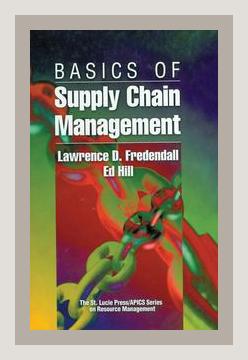Operations and Supply Chain ManagementLogistics
Basics of Supply Chain Management by Lawrence D. Fredendall, Ed Hill (2001): An In-Depth Summary
Introduction
“Basics of Supply Chain Management” by Lawrence D. Fredendall and Ed Hill provides a comprehensive overview of the core principles and practices in supply chain management, particularly focusing on the logistics aspect. Written in 2001, this book effectively bridges theoretical concepts with practical applications suitable for professionals and students alike.
Chapter 1: Introduction to Supply Chain Management
The book begins by defining supply chain management (SCM) as the coordinated management of activities involved in producing and delivering goods and services. The authors explain that an effective supply chain reduces costs and improves quality and customer satisfaction.
Concrete Example: Companies like Dell excel at SCM by directly linking customer orders to their production schedules, allowing them to minimize inventory and meet customer demand efficiently.
Actionable Advice: Evaluate your current supply chain processes to identify bottlenecks. Implement data-sharing techniques with suppliers to enhance visibility and coordination.
Chapter 2: Supply Chain Operations and Planning
Fredendall and Hill delve into the intricacies of supply chain operations and emphasize the importance of strategic planning. They introduce concepts like Material Requirements Planning (MRP) and Manufacturing Resource Planning (MRP II).
Concrete Example: An automotive company used MRP II systems to integrate financial and operational data, leading to more accurate production schedules and reduced costs.
Actionable Advice: Implement MRP or MRP II software to improve forecasting and operational alignment. Train employees on optimal usage of this tool.
Chapter 3: Inventory Management
The discussion on inventory management highlights the balancing act between having enough inventory to meet customer demands and minimizing holding costs. Techniques like Just-In-Time (JIT) and Economic Order Quantity (EOQ) are discussed.
Concrete Example: Toyota’s JIT system allows the company to reduce waste and enhance productivity by receiving goods only as they are needed in the production process.
Actionable Advice: Assess your inventory levels and calculate EOQ to determine the optimal order quantity that minimizes total costs. Consider integrating JIT practices where feasible.
Chapter 4: Logistics and Distribution
Logistics is outlined as the efficient movement and storage of products from manufacturers to end consumers. The authors stress the importance of transportation, warehousing, and distribution strategies.
Concrete Example: Walmart uses cross-docking techniques in its distribution centers to streamline logistics, reducing storage time and enhancing supply chain efficiency.
Actionable Advice: Re-evaluate your distribution network to identify areas for improvement. Implement cross-docking if your operations could benefit from reduced storage times.
Chapter 5: Supplier Relationships
Building strong supplier relationships forms a fundamental part of SCM. Fredendall and Hill discuss the benefits of creating strategic partnerships to improve quality, reduce costs, and foster innovation.
Concrete Example: Apple collaborates closely with its suppliers to ensure high-quality components and innovative manufacturing techniques.
Actionable Advice: Develop a supplier management program that includes regular performance reviews and collaborative improvement plans. Foster open communication and mutual trust.
Chapter 6: Technology in Supply Chain Management
The book emphasizes the impactful role of technology in SCM, from Enterprise Resource Planning (ERP) systems to advanced data analytics and automation.
Concrete Example: Amazon employs sophisticated warehouse automation and real-time data analytics to optimize inventory management and order fulfillment.
Actionable Advice: Invest in ERP systems that integrate various supply chain activities. Explore emerging technologies such as IoT and AI to gain a competitive advantage.
Chapter 7: Performance Measurement
Performance metrics are crucial for monitoring and improving supply chain efficiency. The authors introduce key performance indicators (KPIs) such as fill rate, inventory turnover, and lead time.
Concrete Example: A consumer electronics firm tracks its order fill rate to ensure high customer satisfaction, tweaking its supply chain based on KPI analysis.
Actionable Advice: Establish a robust performance measurement framework. Regularly review KPIs to identify areas that need improvement and implement necessary changes.
Chapter 8: Global Supply Chain Management
Globalization introduces complexities such as cultural differences, varying regulations, and international logistics. Fredendall and Hill explain strategies for managing these challenges.
Concrete Example: A fashion retailer sources materials from multiple countries, navigating different trade regulations and shipping logistics efficiently to meet market demands.
Actionable Advice: Conduct a comprehensive risk assessment of your global supply chain. Develop strategies to mitigate risks such as trade tariffs, political instability, and logistical bottlenecks.
Chapter 9: Demand Management and Forecasting
Accurate demand forecasting is critical for aligning supply chain activities with market needs. Techniques like qualitative assessments and quantitative models are discussed.
Concrete Example: A pharmaceutical company uses advanced forecasting models to predict demand for new drugs based on historical data and market trends.
Actionable Advice: Implement a combination of forecasting methods to enhance accuracy. Encourage cross-functional collaboration to integrate market insights into demand planning.
Chapter 10: Customer Service and Satisfaction
A supply chain’s ultimate goal is to meet or exceed customer expectations. Fredendall and Hill highlight the need for aligning supply chain strategies with customer satisfaction initiatives.
Concrete Example: Zappos is renowned for its exceptional customer service, directly linking supply chain efficiency with high levels of customer satisfaction.
Actionable Advice: Map your customer journey to identify critical touchpoints where supply chain optimization can improve service levels. Implement feedback loops to continually refine processes based on customer input.
Conclusion
“Basics of Supply Chain Management” provides a detailed exploration of each element of the supply chain, offering a combination of theoretical insights and practical guidance. The examples and actionable advice in each chapter equip readers with the knowledge needed to apply effective SCM practices in their organizations.
By leveraging these insights, including adopting advanced technologies, building strong supplier relationships, and improving inventory management, businesses can ensure a robust, efficient, and customer-centric supply chain.
